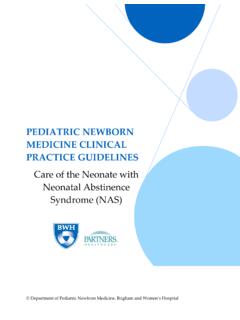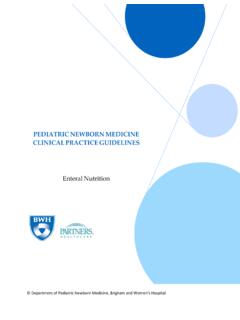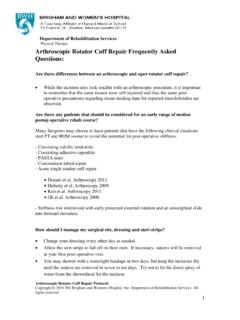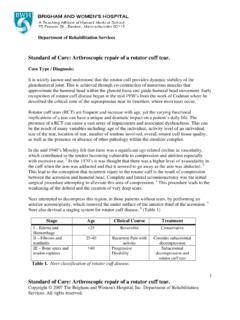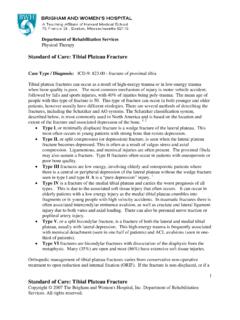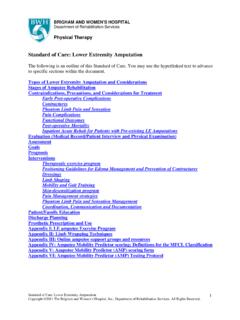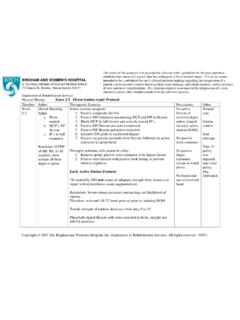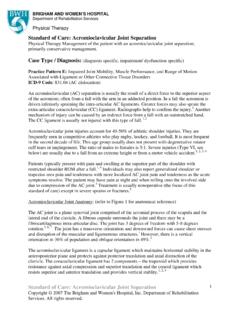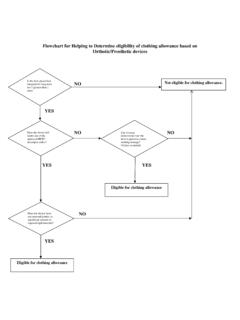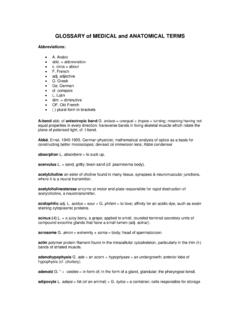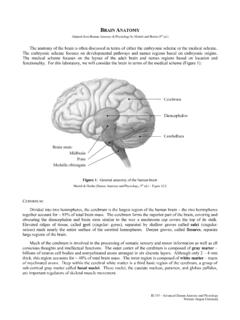Transcription of BASIC APPROACH TO EVALUATING A HEAD CT - Brigham and …
1 BASIC APPROACH TO HEAD CT INTERPRETATION David Zimmerman, Neuroradiology, BWH Contents BASIC principles of CT CT Neuroanatomy Disease Processes evaluated with CT BASIC Physics of CT CT Scanning Hounsfield Unit Measurements Bone ~ +613 HU White Matter ~ + HU Gray Matter ~ + HU CSF - Ventricle ~ + HU Scalp Fat ~ HU Air ~ HU Tissue Density Differences Lower density substances allow more photons pass through to the detectors, resulting in a grayer or blacker appearance on CT like CSF The X-ray beam is attenuated to a higher degree by calcium, therefore less photons pass through bone to the detectors, resulting in its white appearance on CT White matter is less cellular, contains myelinated axons (fat), and has a higher water content than gray matter, resulting in slightly lower attenuation values or density Different Window Levels Brain Window shows subarachnoid hemorrhage (blood proteins/clot)
2 Is high density in the basilar cisterns with small foci of air (red arrows) related to trauma Soft Tissue Window shows scalp hematoma Bone window shows bullet fragment and fracture CT Artifacts Beam Hardening Artifact from Metal Alloy in a Lodged Bullet Streak Artifact in the Coronal Plane Partial Volume Artifact Note the red arrow, in the extra-axial space adjacent to the right cerebellar hemisphere, there is slightly increased density related to averaging of the sigmoid sinus, cerebellum, and CSF in this slice Blue arrow band of streak artifact limits evaluation of the pons CT Neuroimaging The head is routinely scanned using sequential imaging in the axial plane with each section measuring 5 mm thick Helical imaging is used for CT angiograms of the head/neck and other parts of the body Illustrative Neuroanatomy Illustrative Neuroanatomy Illustrative Neuroanatomy Illustrative Neuroanatomy Head CT APPROACH First - evaluate normal anatomical structures.
3 Window for optimal brain tissue contrast Second assess for signs of underlying pathology such as: mass effect, edema, midline shift, hemorrhage, hydrocephalus, subdural or epidural collection/hematoma, or infarction Third evaluate sinuses and osseous structures with bone windows Fourth use a soft tissue window to assess extracranial anatomy orbits, face, scalp Anatomy Red Cerebellar Hemisphere Blue Cerebellar Vermis Green Medulla Pink Masticator muscles Orange Maxillary sinus Anatomy Level of the Pons Purple Sphenoid sinus Yellow cerebellopontine angle Red Middle cerebellar peduncle Orange Temporal lobe Blue Fourth ventricle Anatomy Midbrain Level Yellow Ethmoid sinus Purple Sellar fossa Green Suprasellar cistern Red Cerebral aqueduct Blue Temporal horn of ventricular system Orange
4 Occipital lobe White Middle cerebral artery, note that it is isodense to gray matter Anatomy Green Third Ventricle Yellow Frontal lobe Red Sylvian fissure Blue Temporal lobe Orange Quadrigeminal Plate cistern Anatomy White foramen of Monroe connects lateral to third ventricle Yellow caudate head Blue globus pallidus Red putamen Purple thalamus Green posterior limb of the internal capsule Orange pineal gland with calcification Anatomy White genu of the corpus callosum Red splenium of the corpus
5 Callosum Yellow thalamus Green choroid plexus in lateral ventricle Blue external capsule between the insular cortex laterally and the putamen of the basal ganglia medially Anatomy White body of the caudate Red corona radiata are white matter tracts Yellow falx cerebri Blue superior sagittal sinus Anatomy Yellow centrum semiovale are supraventricular white matter tracts running to and from the cerebral cortex Blue parietal lobe Anatomy vertex or top of the Brain Anatomy White superior frontal gyrus Yellow superior frontal sulcus Red middle frontal gyrus Green prefrontal sulcus Orange motor strip or prefrontal gyrus Blue central sulcus Purple sensory strip or post central gyrus Pink post central sulcus Bone Window - Anatomy Orange inferior orbital fissure Green - foramen lacerum Yellow foramen ovale transmits 3rd division of CN V Red foramen spinosum for middle meningeal artery Purple petrous portion of the internal
6 Carotid artery White jugular vein Bone Window - Anatomy Yellow vidian s canal transmits greater petrosal nerve from CN VII Red clivus Blue carotid canal White jugular vein Green sigmoid sinus Sinuses in the Axial Plane Left to right: frontal sinus, ethmoid sinus, maxillary sinus and sphenoid sinus CT Angiographic Anatomy Red MCA or middle cerebral artery Yellow ACA Green PCA Blue Basilar artery CT Angiographic Anatomy Red anterior cerebral arteries Yellow vein of Galen Purple superior sagittal sinus Green straight sinus Blue basilar artery Pathology on Head CT Can You Find the Abnormality?
7 Left Middle Cerebral Artery Aneurysm on a Non-contrast CT Left Middle Cerebral Artery Aneurysm on a Non-contrast CT Yellow MCA bifercation aneurysm Pink Sylvian fissure Orange Basilar artery Green Supraclinoid ICA Blue Bony dorsum sella TRAUMA Trauma from a gunshot wound Acute hemorrhage is bright on CT, due to increased attenuation of the X-ray photons by blood proteins as clot forms In this case, there is subarachnoid and intraventricular hemorrhage Trauma Same Case Soft tissue windowing shows significant scalp swelling.
8 The left frontal sinus is opacified Diffuse cerebral edema with a subdural hematoma (yellow arrows) have resulted in midline shift of structures to the right side Bone Windows with Lodged Bullet Axial CT images on following slides demonstrate the entry site of the bullet in the right occipital skull with comminuted fracture fragments CT data can be reformatted into the coronal plane to evaluate calvarial fractures STROKE Right Cerebellar Infarct Infarcts are initially ill-defined with lower attenuation/density or darker gray appearance Chronic infarcts are black like CSF because tissue loss from neuronal cell
9 Death liquifies and is known as encephalomalacia Left Cerebellar Infarct Cytotoxic edema in infarctions involves the gray and white matter therefore abnormal low attenuation extends to the cortex Important to know vascular territories: this is a posterior inferior cerebellar artery (PICA) infarct Acute to subacute stage of infarction can lead to mass effect from edema Is There Asymmetry Between the Two Hemispheres? Acute Left Middle Cerebral Artery Territorial Infarction Arterial occlusion from thrombus or embolus causes loss of gray to white matter differentiation when ischemia develops Note the loss of the white cortical ribbon of gray matter in the left hemisphere (yellow arrows) as compared to the normal contralateral side (blue arrows)
10 Dense MCA Sign in Acute Infarct Notice how thrombus is whiter in the occluded left middle cerebral artery on this non-contrast study Subacute Infarction In 5-7 days after the initial event, the completely infarcted area has a well-defined geographic appearance with mass effect Chronic infarcts have volume loss Infarcts can undergo hemorrhagic conversion usually within the first few days Chronic Right Frontal Lobe Infarct note ex vacuo dilatation of the right frontal horn secondary to parenchymal volume loss Chronic Left MCA Infarct with parenchymal volume loss Brain Masses and Edema Hemorrhagic Brain Metastasis Hyperdense mass in the left posterior parietal lobe has a hemorrhagic component
